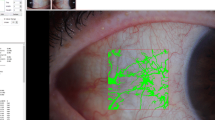Abstract
Using a highly specific radioimmunoassay, post- traumatic aqueous PGE2 levels were measured in rabbit eyes treated with topical indomethacin aqueous solution, as well as in untreated eyes. In two groups of ten rabbits each, the surgical trauma consisted of corneoscleral incision (without injury to the iris); one of the two groups received prophylactic treatment (3 days) and therapeutic (21 days) indomethacin treatment. In two other groups of ten rabbits each, corneoscleral incision and iridectomy were performed. One group received indomethacin treatment as described above, while the other group was not treated. Surgery was performed in all 40 right eyes, the left eyes serving as controls. In 20 of the 40 left eyes, indomethacin therapy was applied. In all right and left eyes, aqueous samples were withdrawn 3 days and 21 days postoperatively, and PGE2 concentrations were determined. The results indicate that 3 days after corneal trauma and 3 days after corneal trauma plus iridectomy, there was a highly significant reduction in the elevated PGE2 concentrations as a result of indomethacin therapy. On postoperative day 21, indomethacin reduced even further the still slightly elevated aqueous PGE2 concentrations without, however, completely blocking prostaglandin activity. The latter was observed even in the control animals that were not operated upon; they showed minimal PGE2 levels in response to corneal puncture on postoperative day 3 for the purpose of drawing aqueous samples. Our study demonstrated that short-term indomethacin therapy has a significant inhibitory effect, but no unequivocal answers were found as to the value of long-term treatment.
Similar content being viewed by others
References
Ambache N, Brummer HC (1968) A simple chemical procedure for distinguishing E from F prostaglandin with application to tissue extracts. Br J Pharmacol 33:162–169
Ambache N, Kavanagh L, Whiting J (1965) Effect of mechanical stimulation on rabbit's eyes: release of active substances in anterior chamber perfusates. J Physiol (Lond) 176:378–382
Béchetoille A, Baikoff G (1980) Prostaglandin synthesis inhibitors in intra-ocular surgery. Experimental bases in first clinical trials. In: Prostaglandin synthetase inhibitors: new clinical applications. Alan R. Liss, New York, pp 187–195
Cole DF, Unger WG (1973) Prostaglandins as mediators for the responses of the eye to trauma. Exp Eye Res 17:357–368
Fechner PU (1982) Die Prophylaxe des zystoiden Makulaödems mit Indometacin-Augentropfen. Klin Monatsbl Augenheilkd 180:169–172
Granström E, Kindahl H (1979) Radioimmunological determination of 15-keto-13, 14-dihydro-PGE2: a method for its stable degradation product 11-deoxy-13, 14-dihydro-15-keto-13-11-16-epsilon cycloprostaglandin E2. Proceedings of the 4th International Prostaglandin Conference May 27–31, 1979, Washington DC, p 42
Haeringen N van, Glasius E, Oosterhuis JA, van Delft JL (1983) Drug prevention of blood-aqueous barrier disruption. Ophthalmic Res 15:180–184
Hollwich F, Jacobi K, Küchle HJ, Lerche W, Reim W, Straub W (1983) Zur Prophylaxe des zystoiden Makulaödems mit Indometacin-Augentropfen. Klin Monatsbl Augenheilkd 183:477–478
Klein EM, Bito LZ (1983) Species variations in the pathophysiologic responses of vertebrate eyes to a chemical irritant, nitrogen mustard. Invest Ophthalmol Vis Sci 24:184–191
Kraff MC, Sanders DR, Peyman GA, Liebermann HL, Tarabishy S (1980) Slit-lamp fluorophotometry in intraocular lens patients. Ophthalmology 87:877–880
Kraff MC, Sanders DR, Jampol LM, Peyman GA, Liebermann HL (1982) Prophylaxis of pseudophakic cystoid macular edema with topical indomethacin. Ophthalmology 89: 885–890
Kremer M, Baikoff G, Charbonnel B (1982) The release of prostaglandins in human aqueous humour following intraocular surgery. Effect of indomethacin. Prostaglandins 23:695–702
Miller JD, Eakins KE, Atwal M (1973) Release of prostaglandin E2-like activity into aqueous humor after paracentesis. Invest Ophthalmol 12:939–942
Miyake K, Sugiyama S, Norimatsu I, Ozawa T (1978) Prevention of cystoid macular edema after lens extraction by topical indomethacin. III. Radioimmunoassay measurement of prostaglandins in the aqueous during and after lens extraction procedures. Graefe's Arch Clin Exp Ophthalmol 209:83–88
Neufeld AH, Sears ML (1973) The site of action of prostaglandin E2 on the disruption of the blood-aqueous barrier in the rabbit eye. Exp Eye Res 17:445–448
Oosterhuis JA, van Haeringen NJ, Glasius E, van Delft JL, Swart van den Berg M (1981) The effect of indomethacin on the anterior segment of the eye after paracentesis. Doc Ophthalmol 50:303–313
Rochels R (1984) Tierexperimentelle Untersuchungen zur Rolle von Entzündungsmediatoren bei der Hornhautneovaskularisation. Doc Ophthalmol 57:215–262
Rochels R, Busse MD, Hackelbusch R, Knieper P (1983) Prostaglandinkonzentrationsbestimmungen im Kammerwasser nach Bindehaut-Hornhaut-Verätzungen: Korrelation biochemischer, funktioneller und morphologischer Befunde. Fortschr Ophthalmol 80:145–147
Sanders DR, Goldstick B, Kraff C, Hutchins R, Bernstein MS, Evans MA (1983) Aqueous penetration of oral and topical indomethacin in humans. Arch Ophthalmol 101:1614–1616
Unger WG, Perkins ES, Bass MS (1974) The response of the rabbit eye to laser irradiation of the iris. Exp Eye Res 19:367–377
Unger WG, Butler JM, Cole DF (1981) Prostaglandin and an increased sensitivity of the sympathetically denervated rabbit eye to laser-induced irritation of the iris. Exp Eye Res 32:699–707
Urner-Bloch U (1983) Prävention des zystoiden Makulaödems nach Kataraktextraktion durch lokale Indometacin-Applikation. Klin Monatsbl Augenheilkd 183:479–484
Weinreb RN, Weaver D, Mitchell MD (1985) Prostanoids in rabbit aqueous humor: effect of laser photocoagulation of the iris. Invest Ophthalmol Vis Sci 26:1087–1092
Yanuzzi LA, Landau AN, Turtz AI (1981) Incidence of aphakic cystoid macular edema with the use of topical indomethacin. Ophthalmology 88:947–954
Author information
Authors and Affiliations
Rights and permissions
About this article
Cite this article
Skorpik, C., Paroussis, P., Grasl, M. et al. Effect of indomethacin on aqueous PGE2 levels in rabbits following ocular trauma. Graefe’s Arch Clin Exp Ophthalmol 225, 447–451 (1987). https://doi.org/10.1007/BF02334174
Received:
Accepted:
Issue Date:
DOI: https://doi.org/10.1007/BF02334174




